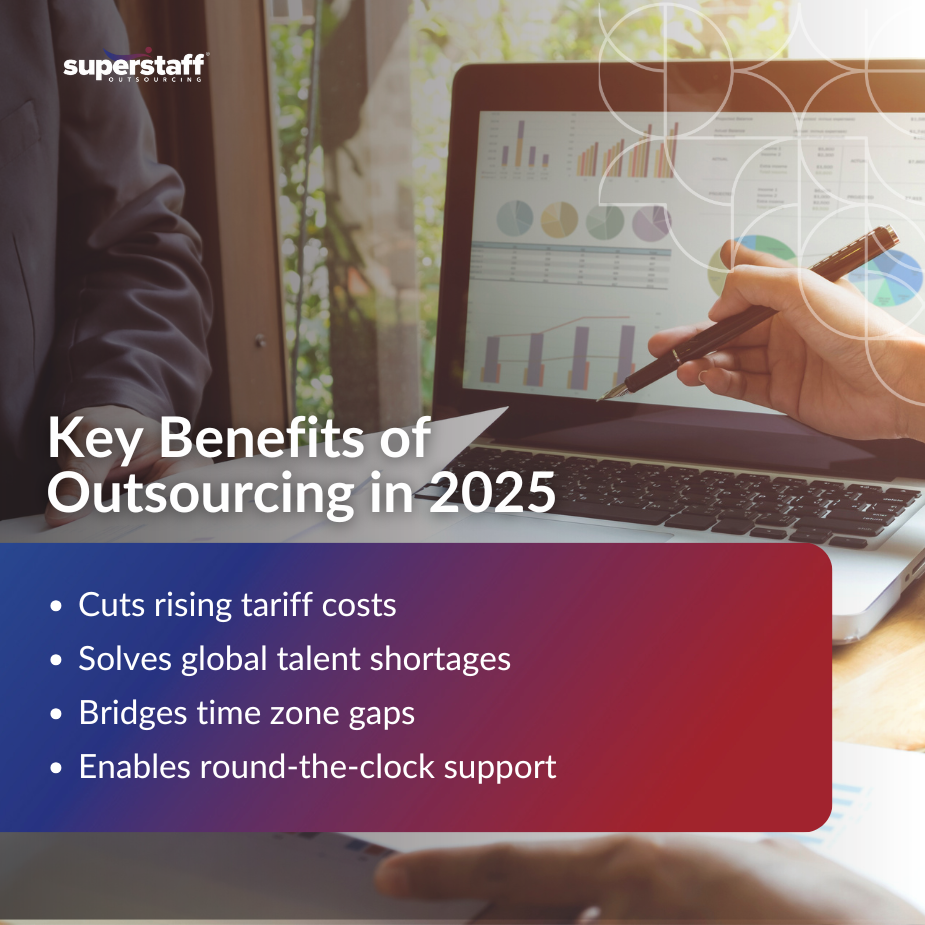
In 2025, U.S. businesses aren’t facing one big challenge—they’re juggling three.
Between rising tariffs, persistent talent shortages, and the complexities of global time zone alignment, staying competitive has never been more difficult. Every decision—from hiring to logistics—feels like walking a tightrope. One misstep, and costs soar, customer service suffers, or innovation stalls. But here’s the good news: The benefits of outsourcing provide a single, powerful solution to these intertwined problems.
This blog explores how global outsourcing empowers companies to manage risk, scale with confidence, and stay competitive despite the mounting triple threat.
Tariff Pressure Is Driving Up Operational Costs Across U.S. Industries
From manufacturing and logistics to healthcare and retail, U.S. companies are seeing their operating costs spiral due to ongoing tariff expansions. These aren’t just temporary headaches—they’re structural threats. The spike in import duties on everything from microchips to medical equipment has disrupted long-established supply chains. Margins are tightening. For many, absorbing those costs simply isn’t an option anymore.
Instead of passing costs to price-sensitive customers, businesses are reevaluating their internal structures. That’s where the benefits of outsourcing start to shine—especially when offshoring functions like customer service, technical support, or financial processing to lower-cost destinations becomes part of the strategy.
Strategic cost-cutting doesn’t mean cutting corners. It means focusing internal resources where they matter most and partnering with outsourcing providers that help companies stay lean without compromising quality.
Outsourcing Helps Offset Tariff-Driven Costs by Reducing Labor and Infrastructure Expenses

One of the clearest benefits of outsourcing is how it slashes operating costs—especially labor. Offshore providers offer highly skilled professionals at a fraction of the U.S. cost. It’s not just about wage differences. Businesses also save on recruiting, training, office space, and the administrative overhead that comes with running in-house teams.
Many companies are now finding that outsourcing gives them more than just cost relief. It provides long-term operational stability. With fixed-rate contracts and built-in scalability, businesses are in a better position to manage financial risk and plan ahead with greater accuracy.
And when tariff costs are unpredictable, the ability to rely on stable outsourcing contracts provides a much-needed layer of financial predictability. Businesses can project costs more accurately, make faster pivots, and reinvest savings into strategic areas.
Talent Shortages Are Stalling Innovation and Scalability for U.S. Firms
Even before the tariff crisis, businesses were battling a labor crunch. Now it’s a full-blown war for talent. From software developers to customer service agents, the struggle to hire is holding back innovation. Companies are bidding up salaries for roles they still can’t fill—and even when they do, burnout and churn are draining morale and budgets.
This is especially true in high-demand fields like healthcare support, IT, and logistics. The benefits of outsourcing become even more apparent here. Rather than compete in an overheated labor market, companies can access skilled professionals globally—many of whom are already trained, certified, and ready to contribute.
For midmarket companies, in particular, outsourcing means finally getting access to the kind of talent that would otherwise be out of reach. It also creates room to scale up or down without navigating complex local hiring laws or relocation costs.
Global Outsourcing Gives Companies Instant Access to Trained, Scalable Talent
The global labor pool is vast—and through outsourcing, it becomes accessible. Leading BPO providers, especially in countries like the Philippines and Colombia, offer deep talent benches across key sectors. Whether it’s accounting, healthcare coordination, or tech support, companies can find precisely the skill sets they need without compromise.
That’s one of the most strategic benefits of outsourcing: instant scalability. Need to launch a customer care team quickly? It’s possible. Need multilingual agents? Already available. Want performance tied to SLAs? Most providers are equipped to deliver.
This kind of flexibility is difficult to replicate in-house, especially for companies managing multiple departments, platforms, and regional teams. Outsourcing makes it easier to fill gaps quickly, while also ensuring continuity across roles and regions.
Time Zone Differences Can Disrupt Workflows, Delay Support, and Hurt Customer Experience
Let’s face it—time zones can kill momentum. A developer in California sends feedback at 5 p.m., but their collaborator overseas won’t see it until the next day. Meanwhile, customers waiting for resolution hear nothing for hours. These gaps cause delays, miscommunications, and lost revenue.
That’s why one of the emerging benefits of outsourcing is geographic strategy. Businesses no longer have to choose between cost savings and responsiveness. The right outsourcing provider gives you both. It’s not just about handing work off to another team—it’s about creating seamless workflows around the clock.
Time zone alignment matters. Whether you need real-time customer support or overlapping hours for collaboration, strategic outsourcing locations give you better options without sacrificing performance.
Outsourcing Provides Time Zone Alignment for 24/7 Operations and Seamless Collaboration
Imagine never missing a customer call again. With nearshore and offshore teams strategically placed across time zones, that becomes the norm—not the exception. That’s one of the most practical benefits of outsourcing today: you’re always open for business.
Colombia, for instance, aligns with U.S. Eastern and Central time zones, making it ideal for real-time operations. Meanwhile, Philippine-based teams provide robust overnight support, covering after-hours queries and back-office needs while your in-house team sleeps.
This around-the-clock model has helped businesses respond faster, boost satisfaction, and stay agile. With multiple support zones operating in tandem, service is never out of sync with customer expectations.
Companies That Outsource Are Turning Disruption into Opportunity
The last few years have tested business continuity on every front—from supply chains and talent pipelines to customer engagement. And through all of it, companies that adopted outsourcing early were better positioned to adapt and thrive.
That’s the long-term value hiding in plain sight. The benefits of outsourcing are no longer just about reducing costs—they’re about building a smarter, more responsive operation. One that scales as needed, runs lean without risk, and aligns resources with revenue-driving functions.
Outsourcing is helping companies move from reactive firefighting to proactive growth planning. In a volatile business climate, that difference is everything.
The Benefits of Outsourcing: Your Strategic Response to the Triple Threat
Outsourcing is the strategic response to the triple threat of tariffs, talent shortages, and time zone challenges. The benefits of outsourcing go far beyond savings—they unlock agility, scalability, and global reach. They allow businesses to respond faster, serve better, and focus on what truly matters: growth.
In a time when change is constant and disruption is the norm, businesses need solutions that offer both stability and speed. Outsourcing delivers exactly that. It bridges gaps. It builds resilience. It moves at the pace of your ambition.
Ready to take that next step? Don’t let tariffs, talent gaps, or time zones hold you back. Talk to SuperStaff today and build a resilient, high-performing global team that moves as fast as your business demands.






